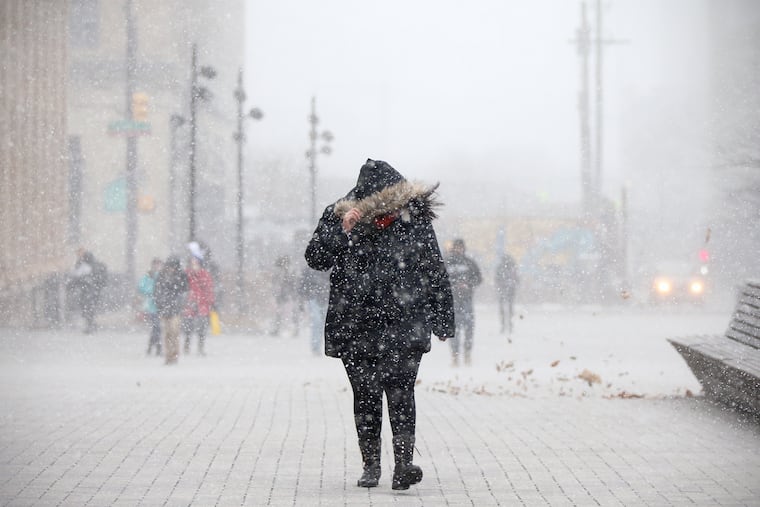How to not get frostbite or hypothermia when the weather is freezing
While curling up under a fuzzy blanket is always a good call, here are some tips from experts.

With an onslaught of freezing winter weather, doctors have one message for Philadelphians: Stay inside as much as possible.
“In order to get frostbite, you have to be out in freezing temperatures,” said Bob McNamara, chair of emergency medicine at Temple University’s Lewis Katz School of Medicine. “So the number-one thing would be to stay inside.”
People should also be concerned about hypothermia, McNamara said, which can occur indoors too, if people don’t have proper heating. “Roughly half the cases of severe hypothermia we see happen indoors,” he said.
But fear not! There is plenty you can do to prepare for the winter not-so-wonderland.
While curling up under a fuzzy blanket is always a good call, here are some tips from experts, including one who’s been to Antarctica.
Frostbite
When the body gets cold, it restricts blood flow to the extremities, prioritizing major organs instead. So the first signs of frostbite include tingling or pain in the fingers, toes, ears, nose, and elsewhere on the face. Numbness and graying patches of skin are more serious indicators that frostbite is setting in.
Older people and young children are at high risk, as is anyone with a medical condition that might affect their circulation.
» READ MORE: How to keep your pets safe in freezing temperatures
How to prevent frostbite
Nothing beats staying indoors, but if you have to venture out, try to spend as little time outside as possible, McNamara said. And go prepared.
Ted Daeschler, a scientist at the Academy of Natural Sciences of Drexel University, has gone on a research expedition in Antarctica, where he and colleagues camped in 5- to 15-degree temperatures.
He said he often wore two pairs of socks, hooded long underwear, a second layer of long underwear, shirt and pants, a fleece jacket, insulated wind pants, a wind jacket, a neck gator, and wool hat and gloves.
“Still there were times when the wind made it too cold to work outside and we remained in our camp,” he wrote in an email.
While you may not need to go to Antarctic levels of preparedness, it’s a good idea to follow the advice your parents gave you as a kid: warm hat, gloves, snow boots, a wind-resistant jacket, and layers of clothing. The air between layers retains heat, McNamara said.
» READ MORE: How to keep your pipes from freezing in cold weather
When to get help for frostbite
"If you catch frostbite early, it can be reversed,” McNamara said.
Mild cases of frostnip, in which the skin feels cold and is just starting to tingle, can be reversed by getting indoors or using a warm bath, he said.
But if the skin becomes pale, waxy, or hard, people should seek medical attention. Those are signs of tissue loss and may require amputation.
“Every winter we see people who lose body parts from frostbite in the city of Philadelphia,” McNamara said.
Hypothermia
When the body is exposed to the cold for long periods of time, it can lose heat faster than it can produce it, causing a dangerously low body temperature, according to the Centers for Disease Control and Prevention. Wet conditions are especially dangerous, even when temperatures are above freezing.
“Hypothermia is a life-threatening condition,” McNamara said. Major organs can stop functioning properly when body temperature drops.
It can be difficult to spot, though. People may have slurred speech, stumble or trip over themselves, and seem confused. “A mistake people can make is to think they just had too much to drink,” McNamara said.
» READ MORE: Tips for staying warm from Philadelphians who work outside
How to prevent hypothermia
Stay inside and stay dry, the CDC recommends. People should check on neighbors and the elderly to make sure everyone has functioning heat. “Not just a space heater,” McNamara said.
When to get help for hypothermia
If you think someone has hypothermia, call 911 and get medical attention, McNamara said.
If you’re stranded or waiting for emergency responders, try to get the person dry, wrap them up in blankets, and get them as warm as possible.
And a warning on alcohol: While some people believe drinking can stave off the cold, it’s actually very dangerous, McNamara said. Alcohol dilates the blood vessels on the skin, making you feel warm. But this process increases heat loss. So you won’t know you’re cold and you’ll be getting colder by the minute, McNamara said.
Another concern doctors in the emergency room see during cold snaps: people with broken bones and head injuries from slipping and falling on ice.
“All the more reason to stay indoors,” McNamara said.
» READ MORE: Biking in the winter: How to ride in freezing weather